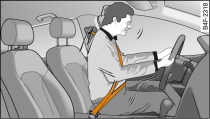
- Fig. 1 Driver protected by the properly worn seat belt during a sudden brake manoeuvre
The common belief that passengers can brace their weight with their hands in a minor collision is false.
It is an established fact that seat belts provide good protection in accidents. Therefore wearing a seat belt is required by law in most countries.
Properly worn seat belts hold the occupants in the best position for maximum protection Fig. 1. The seat belts are capable of absorbing much of the kinetic energy arising in a collision. Also they help to prevent uncontrolled movements which could lead to severe injuries Link.
If they wear the seat belts correctly, the passengers benefit greatly from the ability of the belts to reduce the kinetic energy gradually. The front crumple zones and other passive safety features (such as the airbag system) are also designed to absorb the kinetic energy generated in a collision. Taken together, all these features reduce the forces acting on the occupants and consequently the risk of injury.
Although these examples are based on a frontal collision, the physical principles involved are the same in other types of accidents and for vehicles with an airbag system. This is why it is so important to put on the seat belts before every trip - even when "just driving around the corner". Ensure that your passengers wear their seat belts as well WARNING!.
Properly worn seat belts have been shown to be an effective means of reducing the potential for injury and improving the chances of survival in a serious accident Link.
For information on how children can travel safely in the car Link.
- Seat belts must be put on before every trip - even when driving in town. This also applies to the rear passengers (injury risk).
- During pregnancy, women should always ensure they wear a seat belt. The best way to protect the unborn child is to protect the mother Link.